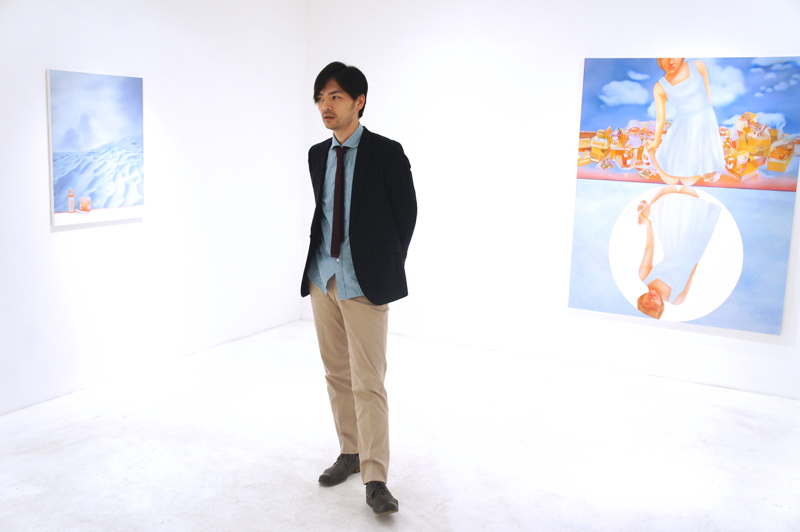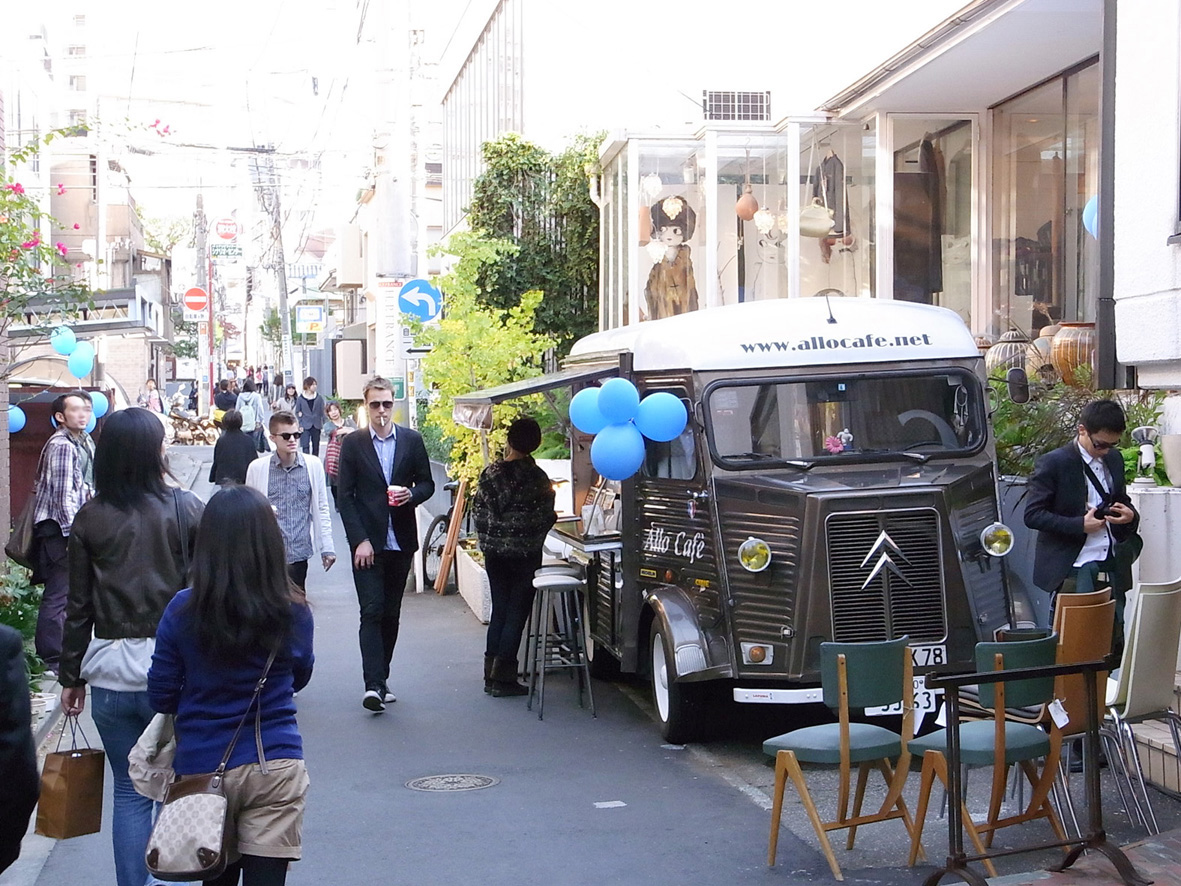KENTARO TOTSUKA
PEOPLEText: Yu Miyakoshi
One artist met a president of the fashion industry and took up the position of bringing artwork into the world. Kentaro Totsuka, the director of ‘hpgrp GALLERY TOKYO’ managed by H.P. FRANCE, works in a variety of fields from curating exhibitions to organizing art events and art fair. At first glance, he is business-like, but his approach is artistic— creating new employment, new fields and cultivating the area. What exactly does this ex-artist think of the art business? SHIFT Japan visited Totsuka, who is busy preparing for an art fair.

Can you tell us how you started doing what you are doing now?
After graduating from the Department of Fine Art, State University of New York, I was working as an artist in New York. In 2004, I held a solo exhibition in a boutique that H.P. FRANCE used to own in New York. There, I met the representative of H.P. FRANCE. “Art, design and fashion do not have walls between them. It all depends on the creator,* the representative told me. and it sounded like an interesting company. Then, after talking to the representative, it was decided that I would work in Japan. After joining the company, I worked on the direction of a fashion exhibition called ‘rooms’ and got to know the process of organizing an event and the structural flow of the fashion industry. In my third year at the company, I founded an art operation department in the company, which is something that I always wanted to make and opened ‘hpgrp GALLERY TOKYO’ in Omotesando.
Aosando Art Fair 2012
You have also organised many art fairs.
It started with the ‘Omotesando Art Fair’, in the year ‘hpgrp GALLERY TOKYO’ was opened, which aimed to attract customers and artists by turning stores in Omotesando into exhibition spaces. After six years on the run, this year over 60 artists will be introduced within 50 stores such as Omotesando Hills, Laforet and Blue Note Tokyo. ‘NEW CITY ART FAIR’ also started this year transmitting Japanese art to the outside world. In the future, the plan is to hold this art fair at the same times with art fairs that are held at the metropolis around the world, such as the New York Art Week on March, ‘ART HK’ in Hong Kong on May, ‘FIAC’ in Paris, October and ‘ART TAIPEI’ in November. Next year, it is decided the ‘NEW CITY ART FAIR Osaka’ will be held on April in Osaka. When organizing art fairs in Japan, it is the opposite of the ones in foreign countries; we try to show foreign art for the Japanese audience.
Why do you introduce art works in the form of Art Fair?
At first, it was because I wanted to attract an audience to my gallery, but around on my second year, my motive started to become clear. This might cause misunderstanding when I say this—I do not intend to protect art or provide the place of exhibiting art works for the artists. It is 100% for the business. It is about how art can be turned into money. Ultimately, because I was not able to sustain my living just by making artworks, I want other artists to become able to make living just by making their works. If this does not work out, it is simply because there is no market for it. Japanese people love art, but there are not so many of us who buy art. As the result, the art market in Japan does not mature and artists have to do part time jobs while making their works and pay money to exhibit their works. This has been the trend for Japanese artists for decades. There sometimes are young curators who open galleries, but it is often the case that they will eventually start doing part time jobs. While artist is busy working part time, gallerists are also working part time. Business-wise, this is an awful situation. Therefore, the primary aim of becoming involved in the art market as a company is to establish art it as a business. As for aims such as ‘growing artists’ or ‘supporting artist’s, from my own experience as an ex-artist, we can do it by ourselves. We make art without someone forcing us to make art and we grow without being supported. Frankly, for artists, gallery should be the place for turning art into money.
By saying this, we do not aim for the few existing art collectors of Japan in the current art market. It is questionable to fight for the limited ‘pai’ with other galleries. Our wish is to produce new art market. This is our biggest proposition.

Participating stores, becoming popular with Aosando Art Fair
It is true that in Japan ‘buying an art piece’ is not a common practice.
I am intending to start with the ‘introduction’. There is a project called ‘LUMINE meets ART’, which has been running for three years. This turns the ‘LUMINE’ building into an exhibition space. LUMINE is situated above a train station, providing the best location, allowing the customers to easily access art pieces without going to an art gallery. For LUMINE, it is a part of their branding strategy, and for the artists, their cost of production is covered. There is a benefit to the both sides, allowing this project to be continued.
‘Omotesando Art Fair’ converts stores into exhibition spaces, and host workshops and parties during the event. By doing this we wanted to plant the idea ‘Art is fun’ to the public. However, unlike fashion it should not be rapidly bought and rapidly consumed. Art sometimes is difficult. You do have to study it to understand and you do have to actively involved in it. But when there is an enjoyment towards art, it will be the entrance to the art world.

Reception party for the NEW CITY ART FAIR, held in New York in March 2012
This year, you were also organizing ‘NEW CITY ART FAIR Taipei’ for the first time.
‘NEW CITY ART FAIR‘ is an art fair with the concept of selling Japanese artists to foreign art fans. Our proposition is to make an art market domestically, and it does take time. We decided to produce scenes to sell our art in a foreign market at the same time. Initially we started off with New York, where H.P. FRANCE owns a gallery. We managed to set up around ten venues, which were quite small for an art venue. We demonstrated to the locals there that ‘in Japan we do have things interesting, come and look at our art’.
Taipei’s fair was already being planned when we started the exhibitions in New York. Taipei does have an art market, and we were beginning to establish a connection to the locals, so we held the art fair alongside the ‘ART TAIPEI‘, which is the oldest art fair in Asia. As a company, we were beginning to direct our strategies so that we can transmit Japanese fashion & lifestyle to the world through the East Asia. ‘roomLINK TAIPEI’, where we brought fashion and art without thinking about the boundary between the two, was the result of that strategy. ‘NEW CITY ART FAIR Taipei’ was an art area inside that.
What was the venue like?
We are held the event in a place called Huashan1914. It is an ex-brewing plant with event spaces, restaurant, bars and galleries, making the place a very creative space. The exhibited works mainly involved Japanese merchandise and art works. But we held an event where we produced furniture out of local waste and various other events around Taipei. We did have connections with ‘ART TAIPEI’ as well. Our events were introduced in their VIP program and we connected the two venues by bus. Our clientèle differed so it was productive for both of the fairs.

‘Rich’s work, which was appointed as the main image for the Omotesando Art Fair was also introduced in NEW CITY ART FAIR Taipei.
Do you feel it is necessary to proceed in conjunction with Asia?
Japan is an island nation so it is difficult—but that cannot be our excuse. By establishing a highly creative standard with the Taiwanese people, we can spread it throughout East Asia. This is also for Japan as well. In Japan, where there is only a small difference between the rich and the poor, we developed a unique fashion market that is neither luxury or cheap. It is highly possible that this kind of market will begin to emerge in East Asia. This is why we should transmit both art and fashion. Japan is a fashionable nation. But this is only because the level of consumer is high. After all the source of transmission is still in the Western countries. If we think ahead, when the East Asia fully matures, Japan should be the country that takes the initiative. Japan will stay as a nation with high level of consumers, if we let other Asian countries to take the initiative. In this sense, ‘NEW CITY ART FAIR Taipei’ that aimed to raise Japanese and Taiwanese lifestyle, is ultimately an event for Japan. If we think in the basis of Western capitalism, we should aim for Beijing and Shanghai next, but I started to feel this value developing elsewhere, so our next move is still unknown.
Do you feel a sense of incompatibility towards the Western Capitalism?
There is something that I noticed recently; the form of Western art scene and the art scene that we are aiming here in Japan might completely be different. What this means is that our aim appeared as though we should produce the art market that we witnessed in foreign countries, where we build white-cube-galleries, galleries represent artists and hold huge art fairs and auctions and attract art collectors. But this sort of Western system is based on their lifestyle, history and other various backgrounds. Why should Japan do the same? When I was walking around Chelsea in New York, there was a photography work with the price of tens of millions. This is amazing but people, who think colors of insects and water droplets falling onto leaves are beautiful does not necessary understand that. Simply taking over the concept that was developed in the West does not work. Traditionally in Japan we never had Western style artists that were sponsored by the kings. What existed in Japan were craftsman, who competed with each other and left amazing works. This kind of ‘beauty’ was completely destroyed after the war. This is why I recently wonder what we should really aim for. Although we are noticing things and gradually altering our aim, ‘NEW CITY ART FAIR’, in my opinion is a market where Japanese sense of value is exported.
There are many expanding possibilities.
How can a new market be produced, and what can be done? This is my current work. ‘hpgrp GALLERY TOKYO’ was established because when people start wanting to buy art, I want the place of purchase to be an art gallery. But this is the final destination. The current young gallery owners must also be wishing for the development of the current art market in 10 or 20 years from now. I happen to be working in a company, so I wish this way of thinking eventually becomes good for the industry, and ultimately for Japan as a country. Anyway, it does not mean anything unless we start making the market, and this is why I am doing the course of action that I talked about. I would like to start looking for the Japanese unique sense of value and original Japanese art as well as widely looking for people who share the same thought with us.
NEW CITY ART FAIR TAIPEI 2012
Date: November 8th – 11th, 2012
Place: Huashan 1914 Creative Park
Fair director: Kentaro Totsuka (hpgrp GALLERY TOKYO)
Sponsored by: H.P. FRANCE
https://www.newcityartfair.com
Text: Yu Miyakoshi
Translation: Akio Usui





